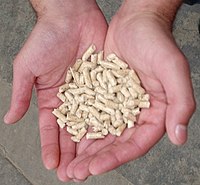
Photo from wikipedia
Direct combustion of solid biomass fuel is one of the most common energy sources in developing countries. Evaluation of technology for household biomass pellet fuel combustion is critical, since promoting… Click to show full abstract
Direct combustion of solid biomass fuel is one of the most common energy sources in developing countries. Evaluation of technology for household biomass pellet fuel combustion is critical, since promoting poorly designed devices may have risks due to exposure to high levels of emissions. This study evaluated the effects of various testing conditions on a top-lit forced-up-draft semi-gasifier cooking stove. An orthogonal test was designed with different fuel masses, chamber heights, air supply rates, and ending points. The investigation showed that using forced secondary air and more fuel tended to improve both thermal and gas emissions performance. The ending points did not have significant effects on thermal efficiency or the carbon dioxide emission factor, but did affect particulate matter emission. A relatively lower chamber height demonstrated better performance on thermal metrics. However, a taller flame had better performance on particulate matter emission factors. The results of the indicators reported by different bases, such as fuel mass-based or useful energy-based were also quite different. The study showed that different testing conditions had significant effects on combustion performances. Testing sequences and emission factors should be reviewed and defined clearly when forming testing methods and standards for biomass pellet fuel combustion.
Journal Title: Energies
Year Published: 2018
Link to full text (if available)
Share on Social Media: Sign Up to like & get
recommendations!